|
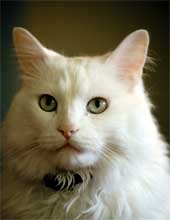 Anti-social: Adult feral cats which are born feral usually cannot be socialized. Adult feral cats that were originally raised domestically can sometimes be reintegrated, but not always. Feral kittens can often be socialized to live with humans if they are taken from a feral colony before they are about twelve weeks old. Anti-social: Adult feral cats which are born feral usually cannot be socialized. Adult feral cats that were originally raised domestically can sometimes be reintegrated, but not always. Feral kittens can often be socialized to live with humans if they are taken from a feral colony before they are about twelve weeks old.
Makeshift Homes: Feral cats may live alone, but are usually found in large groups called feral colonies with communal nurseries, depending on resource availability. Many abandoned pet cats join these colonies out of desperation. The average life span of a feral cat that survives beyond kittenhood is usually cited as less than two years, while a domestic house cat lives an average of twelve to sixteen years. However feral cats aged nineteen (Cat Action Trust) and twenty-six (Cats Protection) have been reported where food and shelter are available.
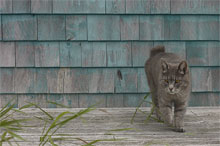 Life in the City: Cityscapes and North America are not native environments for the cat. The domestic cat comes from temperate or hot, often dry, climates and was distributed throughout the world by humans. Cats are extremely adaptable and feral felines have been found in conditions of extreme cold and heat. They are more susceptible to cold, damp conditions than to cold alone. With a need for a diet of 90% protein, many feral cats lack adequate nutrition. In addition, they have no defense against or understanding of such predators as dogs and coyotes. The current population of twenty to forty million feral felines in the United States is due, initially, to human interference by environmental introduction and later, by simple human irresponsibility and neglect. Life in the City: Cityscapes and North America are not native environments for the cat. The domestic cat comes from temperate or hot, often dry, climates and was distributed throughout the world by humans. Cats are extremely adaptable and feral felines have been found in conditions of extreme cold and heat. They are more susceptible to cold, damp conditions than to cold alone. With a need for a diet of 90% protein, many feral cats lack adequate nutrition. In addition, they have no defense against or understanding of such predators as dogs and coyotes. The current population of twenty to forty million feral felines in the United States is due, initially, to human interference by environmental introduction and later, by simple human irresponsibility and neglect.
Behavioral Therapy: Some adult feral cats can be socialized, depending on the degree of human interaction throughout their lives; feral kittens have a good chance of socialization and adoption up to about four months of age.
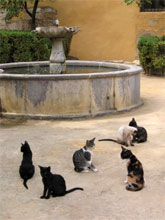 In the United States, there is an ongoing debate about how to deal with feral cat populations. There is little doubt that feral cats are extremely effective at controlling or even eradicating small animal populations, and some cite the utility of cats in controlling populations of verminous rodent species. That is one of the major justifications for the keeping of farm cats. However, conservationists argue that feral cats contribute greatly to the killing of songbirds and other endangered birds, with estimates that bird loss is at 100 million a year due to predation. However research into the causes of bird deaths has also found that transparent windows constitute the biggest threat that birds face. Additionally, it is argued that the resurgence of other small predators such as the gray fox (urocyon cinereoargenteus), fisher or pekan (martes pennanti), coyote (canis latrans), and bobcat (lynx rufus) is a contributing factor in conserved bird deaths. Many of these animals also prey on feral cats. In the United States, there is an ongoing debate about how to deal with feral cat populations. There is little doubt that feral cats are extremely effective at controlling or even eradicating small animal populations, and some cite the utility of cats in controlling populations of verminous rodent species. That is one of the major justifications for the keeping of farm cats. However, conservationists argue that feral cats contribute greatly to the killing of songbirds and other endangered birds, with estimates that bird loss is at 100 million a year due to predation. However research into the causes of bird deaths has also found that transparent windows constitute the biggest threat that birds face. Additionally, it is argued that the resurgence of other small predators such as the gray fox (urocyon cinereoargenteus), fisher or pekan (martes pennanti), coyote (canis latrans), and bobcat (lynx rufus) is a contributing factor in conserved bird deaths. Many of these animals also prey on feral cats.
While it is widely agreed that the loss of conserved species due to fragmentation of native habitat by humans far exceeds deaths due to feral cat predation, some still feel it is necessary to control feral populations.
Cat Hunting: Websites such as The Feral Cat Hunt advocate culling feral cat populations by hunting, arguing that it is the most cost effective method of population control. However, a proposal in the state of Wisconsin to legalize the hunting of feral cats in an attempt to reduce their population (April 2005) was blocked by the state's lawmakers. South Dakota and Minnesota allow wild cats to be shot.
Cat Rehab: Trap-Neuter-Return or TNR programs, presented as a humane method of feral cat population control, are facilitated by many volunteers and organizations in the States. These organizations trap and sterilize feral cats as well as providing inoculation against rabies and other viruses. Sometimes long-lasting flea treatments are also applied before release. Frequently, attending veterinarians cut the tip off one ear to mark the individual as spayed or neutered and inoculated, as these cats will more than likely find themselves trapped again. Volunteers often continue to feed and give care to these cats throughout their lives, unfortunately, it becomes very difficult to domesticate and adopt a feral cat unless it is trapped and socialized before four months of age.
October 16 is National Feral Cat Day in the United States.
Outback Cat: 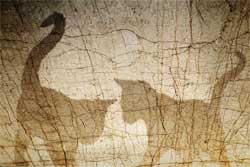 It has been suggested that feral cats have been present in Australia since before European settlement, and may have arrived with Dutch shipwrecks in the 17th century. However historical records do not suggest this, instead dating the arrival of feral cats at around 1824 (Abbot 2002). Intentional releases were made in the late 19th century to control mice, rabbits and rats. Cats had colonized their present range in Australia by 1890. Evidence for early predation by cats having caused major and widespread declines in native fauna is circumstantial and anecdotal and its credibility and significance is debated (Abbot 2002, Dickman 1996). It has been suggested that feral cats have been present in Australia since before European settlement, and may have arrived with Dutch shipwrecks in the 17th century. However historical records do not suggest this, instead dating the arrival of feral cats at around 1824 (Abbot 2002). Intentional releases were made in the late 19th century to control mice, rabbits and rats. Cats had colonized their present range in Australia by 1890. Evidence for early predation by cats having caused major and widespread declines in native fauna is circumstantial and anecdotal and its credibility and significance is debated (Abbot 2002, Dickman 1996).
Strict Diet: Feral cats in Australia prey on a variety of wildlife. In arid and semi-arid environments introduced European Rabbits and House Mice are the dominant part of the diet; in forests and urbanized areas native marsupial prey forms the larger part
of the diet (based on 22 studies summarized in Dickman 1996). In arid environments where rabbits do not occur native rodents are taken. Birds form a smaller part of
the diet, mostly in forests and urbanized areas, reptiles also form just a small part
of the diet.
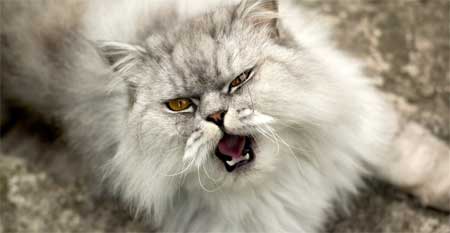
Cat Plague: Numerous Australian environmentalists and conservationists claim that the feral cat has been an ecological disaster in Australia, inhabiting most ecosystems except dense rainforest, and being implicated in the extinction of several marsupial and placental mammal species (Robley et al 2004). Scientific evidence has been hard to come by to support this view and some researchers disagree with it (Abbot 2002). Sound evidence that feral cats exert a significant effect on native wildlife throughout the mainland is lacking (Dickman 1996; Jones 1989; Wilson et al. 1992). Difficulties in separating the effects of cats from that of foxes (also introduced) and environmental effects have hindered research into this. Cats have co-existed with all mammal species in Tasmania for nearly 200 years. Tasmania is fox free. The Western Shield program in Western Australia, involving broad-scale poisoning of foxes, has resulted in rapid recoveries of many species of native mammals in spite of the presence of feral cats throughout the baited area. However in 2005 a study was published which for the first time found proof of feral cats causing declines in native mammals (Risbey et al 2005); an experiment conducted in Heirisson Prong compared small mammal populations in areas cleared of both foxes and cats, of foxes only, and a control plot. Researchers found that mammal populations were lower in areas cleared of foxes only and in the control plots.
Cats may also play a further role in Australia's human altered ecosystems; with foxes they may be controlling introduced rabbits, particularly in arid areas, which cause ecological damage (Robley et al 2004). Cats are not believed to have been a factor in the extinction of the only mainland bird species to be lost since European settlement, the Paradise Parrot; their role in the loss of rare species on Australasian islands, however, has been significant.
Attack of the Giant Cat: Folklore has it that some feral cats in Australia have grown so large as to cause inexperienced observers to claim sightings of other species, and subsequent news stories of mysterious animals being sighted. Typical locations for such sightings are south-west Western Australia, and the Nullarbor.
Born to be Wild: Control programs are difficult to devise due to the nocturnal and solitary nature of feral cats, broad distribution in the landscape and continuous additions to the population from abandoned domestic cats. Due to the danger posed to humans handling the animal, captured feral cats are almost always killed. Although trap neuter and return programs such as those in the United States are not prevalent in Australia, they are now being introduced in some urban and suburban areas such as Adelaide. More recently, such programs have been introduced in Sydney by the "World League for Protection of Animals".
 Ancient Cat World: Rome, Italy is perhaps the place with most feral cats, the total number being estimated between 250,000 and 350,000, organized in about 2,000 colonies, some of them living in famous ancient places such as the Coliseum. Ancient Cat World: Rome, Italy is perhaps the place with most feral cats, the total number being estimated between 250,000 and 350,000, organized in about 2,000 colonies, some of them living in famous ancient places such as the Coliseum.
An Island Vacation: Feral cats introduced to islands with ecologically naive fauna, that is species that have not evolved or have lost predator responses for dealing with cats (Moors & Atkinson 1984), have had a devastating impact on these islands' biodiversity. They have been implicated in the extinction of several species and local extinctions, such as the huitas from the Caribbean and the Guadeloupe Storm-petrel from Pacific Mexico. Moors and Atkinson wrote, in 1984, "No other alien predator has had such a universally damaging effect." Given the damage they do, many conservationists working in the field of island restoration (literally restoring damaged islands through removal of introduced species and replanting and reintroducing native species) have worked to remove feral cats. As of 2004, 48 islands have had their feral cat populations removed, including New Zealand's network of offshore island bird reserves (Nogales et al, 2004), and Australia's Macquarie Island. Larger projects have also been undertaken, including their complete removal from Ascension Island. The cats, introduced in the 19th century, caused a collapse in populations of nesting seabirds. The project to remove them from the island began in 2002, and the island was cleared of cats by 2004. Since then seven species of seabird which had not nested on the island for a hundred years have returned.
Feral cats, along with rabbits and some sea birds, are the entire animal population of the remote Kerguelen Islands in the southern Indian Ocean.
The Cats of Canada's Parliament: For many years (tradition associates them with a British garrison of the 1850s), a feral cat colony has existed on Canada's Parliament Hill in Ottawa. In recent years, living structures have been built for them, and they are fed by a volunteer who is given a stipend by the House of Commons. Veterinary services are donated by doctors in the city, and most of the cats are sterilized. At any given time, about fifteen cats live in the colony. The present Canadian Prime Minister, Stephen Harper, is a cat fan and takes feral kittens into his home to socialize them before they are put up for adoption in Ottawa's shelters. Visitors to his official residence can expect to be asked if they have room in their homes for a cat.

Cat Colony: Feral cats colonies often arise from stray or abandoned unneutered cats. The cats breed rapidly and have multiple-kit litters although relatively few kittens survive to breeding age. Often the owners do not have the capacity or desire to care for a large number of cats.
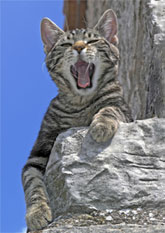 Life on the Streets: The conditions lived in by feral cats vary immensely. Some have short, dangerous, unhealthy, desperate lives, in deplorable conditions. Others are welcomed as working cats around factories and farms and while their lives are not luxurious, some live well into their teenage years. Cat Action Trust has encountered ferals up to 19 years old; the record age for a feral is 26. Because of the perceived dangers to humans, other species, and the cats themselves, and out of compassion toward the animals, many people, including celebrities such as Bob Barker, campaign to encourage people to spay and neuter their pets and support the humane control of feral cats. Life on the Streets: The conditions lived in by feral cats vary immensely. Some have short, dangerous, unhealthy, desperate lives, in deplorable conditions. Others are welcomed as working cats around factories and farms and while their lives are not luxurious, some live well into their teenage years. Cat Action Trust has encountered ferals up to 19 years old; the record age for a feral is 26. Because of the perceived dangers to humans, other species, and the cats themselves, and out of compassion toward the animals, many people, including celebrities such as Bob Barker, campaign to encourage people to spay and neuter their pets and support the humane control of feral cats.
A growing number of animal societies realize that feral cats are wild animals and should not be judged by pet animal standards. Where the cats perform a useful task or are not a threat to the local ecology, the approach is to trap, neuter and return them to their own habitat, while removing any ill, injured or tamable individuals.
Unfortunately recent studies published in the Journal of the American Veterinary Medical Association indicate that trap-neuter-release programs are not effective in reducing feral cat populations. These programs cannot be effective unless they manage cats on a population--rather than colony--basis, neuter at least 75% of the cats in the population, and carrying capacity is reduced, usually by reducing the amount of food provided to the cats by humans.
All text is available under the terms
of the GNU Free Documentation License
|
